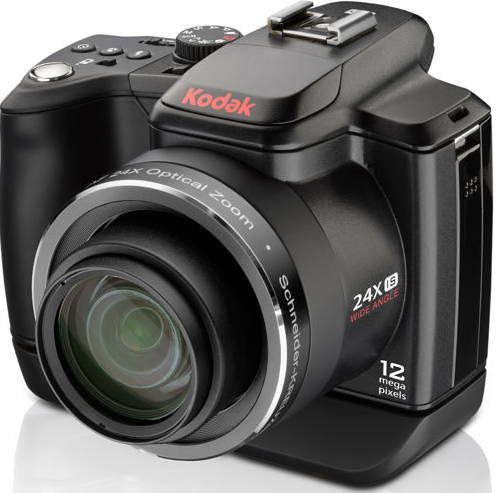
I’ve been avoiding this moment for a month. Before I left for Europe, Kodak sent me their latest ultra-zoom camera, the Z980, and I’ve been carrying it for over 30 days and through five countries. I’ve taken about two hundred photographs and I’ve gotten to know this thing fairly well. My initial conclusion? I’m going to say this just to get it over with: I miss my DSLR. Now, read on for a bit of clarification.
The Kodak Z980 is Kodak’s $399.99 ultrazoom camera. It is a 12-megapixel monster with 24x optical zoom and flash. It has a huge 3-inch back LCD and a false, LCD-based viewfinder. There are multiple modes including Manual, Scene, Auto, and Aperture- and Shutter-priority. It also takes video in full HD. It also takes panoramic photos using a built-in stitching system.
First, my quick look from a few weeks ago:
The Good – The zoom is quite stunning. I doubt many of us have used a lens this long and the ability to bring distant scenes into focus without much blur is impressive. This is by far the camera’s biggest selling point.
The pictures are clear and nicely balanced. In the bright sunlight we were able to take consistently acceptable vacation snaps. With a bit of tweaking we were able to get strong performance in most light although most of the best shooting was outdoors. The panorama mode, for example, was dead simple and allowed us to take some cool shots of Malta and Rome.
The camera has a nice wide ISO zone from – 64 to 6400 – and bracketing. There is no manual white balance but it shots 1fps in burst mode.
This, in a nutshell, is fine for 80% of the prosumer market. Birdwatchers and vacationers will enjoy shooting with the Z980. However, I have reservations about recommending the camera to those who might fall into that 20% set of consumers who are looking for something a bit more powerful than a standard point-and-shoot.
The Bad – Because that’s what the Z980 – a point-and-shoot bolted onto a large lens. And the lens, a SCHNEIDER-KREUZNACH VARIOGON, is great. The click speed is about as fast as a standard point-and-shoot and although you can reduce the wait by turning off preview mode you still have about two seconds lag between most photos unless you’re in a special mode. At 12-megapixels you suffer from both lag and then, when you check the pictures on the LCD, you discover the poor quality of the LCD which blurs the pictures to heck and back and offers a pale imitation of what you can expect when you see the pictures on the desktop.
Then you stumble upon some decidedly odd design choices. Instead of depending on the orientation sensor built-in the camera has a “sideways” switch which activates a buttom on the right edge of the camera and changes the way the buttons on the back work. This decision is baffling and Kodak explained that they couldn’t get the position sensor to work under the requirements they had in terms of design and price. They even included a little thinger you connect to the bottom to make it easier to hold – and bigger. This camera doesn’t need to be any bigger.
Finally, the physical design is garbage. For example, the lens cap is junk. It fell off constantly and the camera lay in my bag with the glass exposed for most of the trip. One good drop and this thing is toast. Once the battery compartment opened randomly spraying batteries all over the street. In real world travel this is a major issue.
Finally, this thing is big. It takes four AA batteries – included – and is as big as a Canon or Nikon DSLR. So there we find the crux of my argument: why buy a $399 ultrazoom when you can get a DSLR with similar functionality and buy a zoom lens. Now, the most obvious reason against this course of action is price and if that’s your only concern then go out and get the Z980 right now if you need the 27x zoom for a specific purpose. It’s a strong camera and there are ways to work around its limitations.
However, the additional features and speed you’d get for a $200 bump in price with a DSLR – excluding the zoom lens – is fairly compelling. The ultrazoom category is obviously very specific to the consumer and I see a place for it. The Z980 is a good camera. It takes great pictures and is fun to use. But I missed my Rebl. I would have been fine not being able to take the tip of a church steeple from 500 feet away. The artifacts I got when shooting with the zoom lens were quite distracting. As you can see from this zoom example, the power and potential is stunning but the results are less so.
The Zoom

Bottom Line – Kodak makes a nice camera. They’ve redefined the low-end of the market and this is a strong addition to their portfolio. But, again, I’m not a fan of ultra-zoom cameras. This camera is bulky and its relative limitations hamper its otherwise impressive and pleasing performance. Comparing and contrasting this model with slightly more expensive DSLRs is a must, just as you would when dealing with any ultrazoom camera from any manufacturer.





